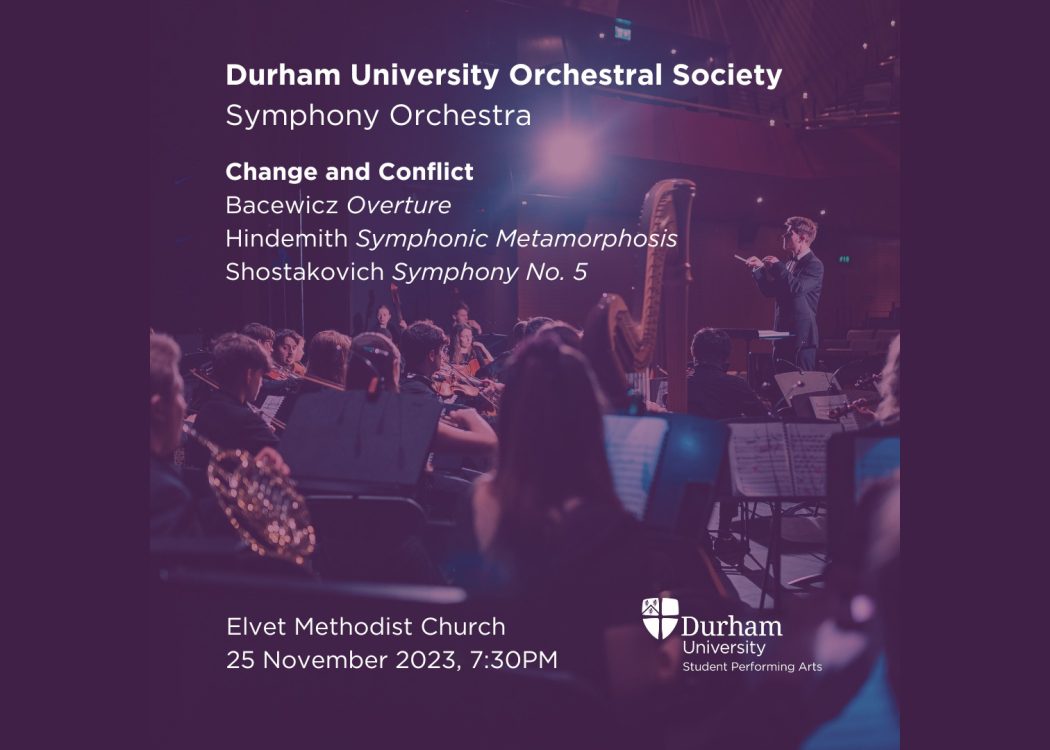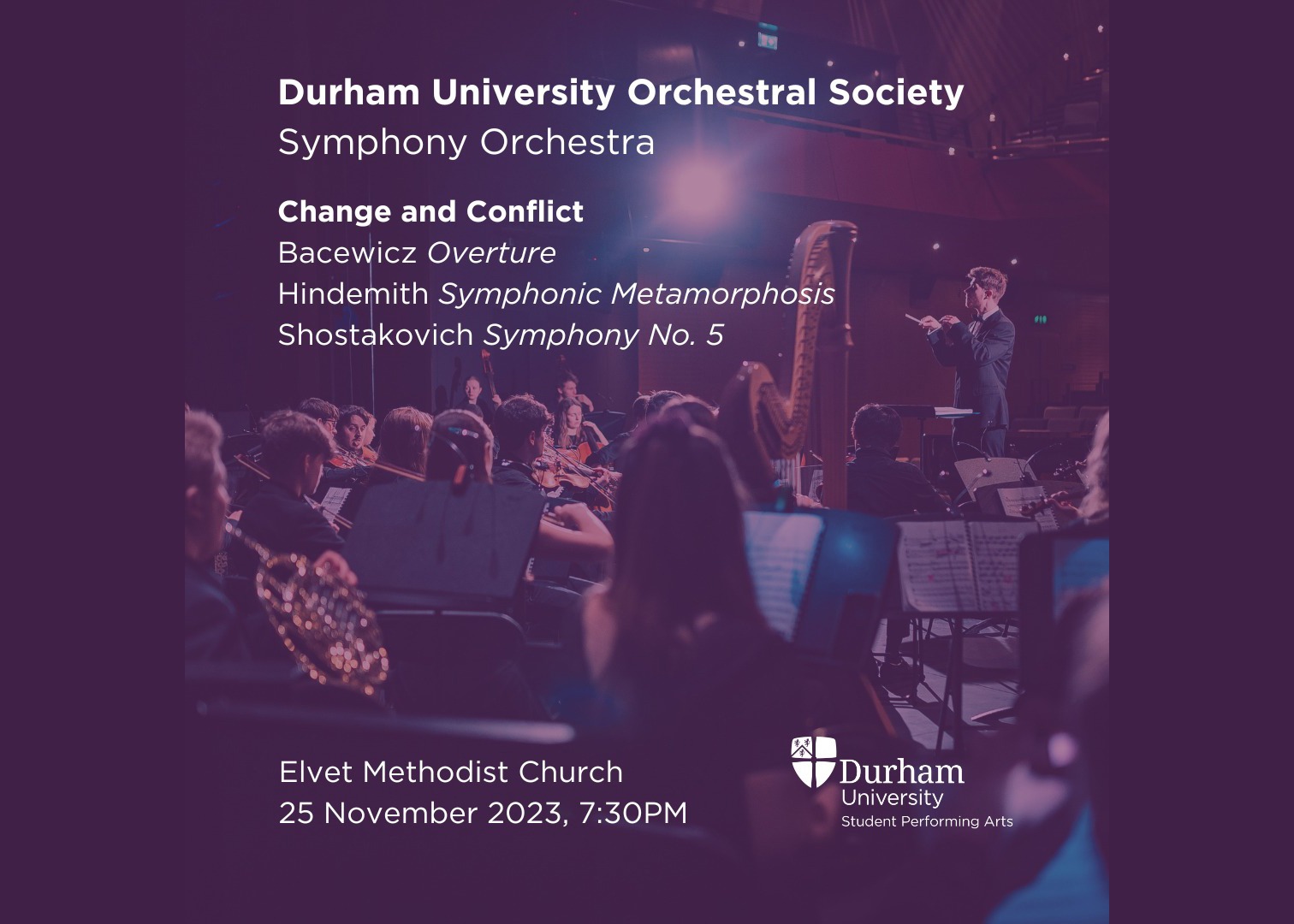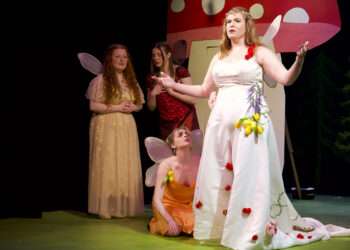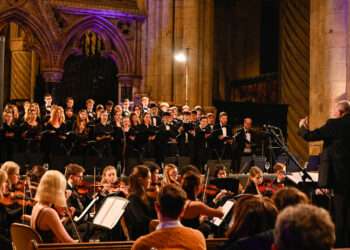As I’ve been adding university concerts to my listings over the last few weeks, I’ve been struck that almost every single programme has included music by a woman. I don’t know if this is happy coincidence or an active policy by Durham Student Music. Either way, I look forward to the day when it doesn’t need to be remarked on, and the university musicians moving us towards that.
In fact, I first came across the name of the Polish composer Graźyna Bacewicz when the chamber ensembles of Royal Northern Sinfonia included her 1932 Wind Quintet in their programme for Musicon (reviewed here for me by Zoe Solomon). DUOS Symphony Orchestra gave us a larger scale work by Bacewicz to open their Michaelmas term concert ‘Change and Conflict’ at Elvet Methodist church.
‘Overture’ was written in the depths of the Second World War, and like the Shostakovich symphony that came later in the concert, its mood was elusive – on the surface it seemed defiant, with a repeated four-note rhythm that may have intentionally signalled a morse code V for victory, but this was a nervy defiance, fuelled by adrenaline, always looking over the shoulder. The strings gave a dark tone to the busy opening and apart from a gentle wind section, the piece bristled with a spiky energy.
The orchestra had to contort the traditional layout into a T-shaped formation to fit into the church, with the wind, brass and percussion backed up into the chancel and the strings spread wide across the front. It must have played havoc with communication and sightlines across the orchestra, so full credit to conductor Monty Milner for holding it all together. All three pieces in this well-constructed programme were notable for their composers’ use of colour and texture and Milner and the orchestra made sure we heard every detail, starting with a lovely clarinet line in the Bacewicz.
More colour followed in Paul Hindemith’s Symphonic Metamorphosis on Themes by Carl Weber, written in 1940, from the safety of New York. The opening movement very much had the feel of being Weber dressed up in 20th century clothes and a fun solo for the oboe. Hindemith took his themes from some incidental music Weber wrote for a play based on the same story as Puccini’s Turandot and the oriental theme was particularly evident in the second movement, subtitled ‘Scherzo (Turandot)’, with flute and bells and pentatonic scales. I particularly enjoyed the sadder third movement, in which Milner drew menacing but beautifully shaped interjections from the strings under the bassoon and flute solos. The Metamorphosis ended with the brass dominating a lively march, DUOS giving it a real sense of purpose – this was not an army on parade, but out on a mission, leading us into the interval with a thunderous conclusion.
What Dmitry Shostakovich meant when he wrote his Fifth Symphony and how to perform it is a subject of endless debate. Is it triumphant, as the Soviet audiences heard it, or an ironic defiance, or tragic? I ’m not going to attempt to go into it, but suffice to say it offers conductors and audiences plenty of options. Monty Milner and DUOS went for the tragic, starting with a slow, introverted opening, filled with sadness – an approach which worked well for an orchestra with a solitary double bass – and there were nice contrasts in mood as the movement developed.
The orchestra danced through the second movement, with an elegant solo from leader Alison Roberts. The third movement was tender and sad, and again beautifully shaped. It felt like a quiet and dignified gathering that began with a single person’s grief and ended with an entire nation. There were many excellent wind solos throughout the evening, played, I assume, by principals Penny Cairney-Leeming (flute), Luke Owlett (oboe), Madeleine Jablonowska (clarinet) and David Tigue (bassoon) but it was the fiendishly high oboe solo in this movement that really stood out. The layout of the orchestra was particularly effective in this movement too, as the spread-out strings wrapped us in sound.
For the finale the orchestra were well and truly let off the leash – this was a defiant blast. The orchestra benefited from this big shot of adrenaline as signs of tiredness earlier in the symphony were well and truly banished and even a bit of confusion in one section didn’t snap the energy. The symphony ended with a howl of agony, dark and painful. Last year I saw on a Russian friend’s facebook page a picture of a government propaganda billboard near the Bolshoi Theatre in Moscow that claimed that Shostakovich had been ‘cancelled’ in the West. Of course he’s not – and of all the composers the designer of this poster could have chosen, Shostakovich more than anyone speaks to us of the seemingly everlasting suffering of the Russian people. I’m not sure the current powers in Moscow would have approved of this performance though, with its dark, painful ending, Milner and DUOS holding nothing back.









